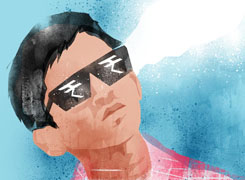Retirement planning at 39: Top mid-cap and small-cap funds for a 39-year-old couple?
Ramalingam Kalirajan |9615 Answers |Ask -Follow
Mutual Funds, Financial Planning Expert - Answered on Jul 22, 2024
He has an MBA in finance from the University of Madras and is a certified financial planner.
He is the director and chief financial planner at Holistic Investment, a Chennai-based firm that offers financial planning and wealth management advice.... more

Im 39, my husband 42 both working. 10L MF started from Jan'24. Risk appetite is moderate. Pls suggest top Midcap and Smallcap MF for one time and SIP investment?
Mid-cap Mutual Funds
Mid-cap funds invest in companies with medium market capitalisation. These companies have the potential for high growth but come with moderate risk. Here are key points to consider:
Fund Performance: Choose funds with a consistent track record of outperforming their benchmarks over a 5-10 year period.
Fund Management: Look for funds managed by experienced fund managers with a strong research team. This ensures better stock selection and risk management.
Diversification: Select funds that are well-diversified across sectors to mitigate sector-specific risks.
Expense Ratio: Opt for funds with a reasonable expense ratio to maximise your net returns.
Small-cap Mutual Funds
Small-cap funds invest in companies with small market capitalisation. These companies offer high growth potential but also come with higher volatility. Here are some key considerations:
Growth Potential: Small-cap funds have the potential for significant growth. However, they can also be more volatile, especially during market downturns.
Fund Management: Experienced fund managers play a crucial role in navigating the volatility of small-cap stocks. Choose funds with a proven track record.
Long-term Investment: Small-cap funds are best suited for long-term investments to ride out short-term volatility.
Risk Management: Ensure the fund follows a robust risk management strategy to protect your investment during market downturns.
Disadvantages of Index Funds and Benefits of Actively Managed Funds
Index Funds: Index funds track a market index and aim to replicate its performance. They offer lower expense ratios but lack the potential for outperformance. They do not provide the benefit of active stock selection or market timing.
Actively Managed Funds: Actively managed funds can outperform the market due to the fund manager’s expertise. They involve higher expense ratios but can deliver higher returns, especially in dynamic markets.
Disadvantages of Direct Funds and Benefits of Regular Funds through MFD with CFP Credential
Direct Funds: Direct funds have lower expense ratios as they do not include distributor commissions. However, they lack professional guidance and advice.
Regular Funds: Investing through a Mutual Fund Distributor (MFD) with CFP credentials provides ongoing advice and portfolio reviews. This helps in making informed decisions and adjusting the portfolio based on market conditions.
Recommended Approach for One-time and SIP Investments
One-time Investments: For one-time investments, choose funds with a strong historical performance and a proven track record. Diversify across 2-3 mid-cap and small-cap funds to balance risk and return.
SIP Investments: For SIP investments, choose funds with consistent performance and lower volatility. SIPs help in averaging the cost of investment and mitigate the impact of market volatility.
Monitoring and Rebalancing
Regular Review: Monitor the performance of your mutual funds regularly. Ensure they continue to meet your investment objectives and risk tolerance.
Rebalancing: Periodically rebalance your portfolio to maintain your desired asset allocation. This helps in managing risk and optimizing returns.
Final Insights
Your decision to invest in mutual funds is commendable. With a well-planned approach, you can achieve your financial goals while managing risk. Regular reviews, professional advice, and a disciplined investment strategy will help you stay on track. Choose mid-cap and small-cap funds with strong track records, experienced fund managers, and robust risk management strategies.
Best Regards,
K. Ramalingam, MBA, CFP,
Chief Financial Planner,
www.holisticinvestment.in
You may like to see similar questions and answers below
Omkeshwar Singh | Answer |Ask -Follow
Head, Rank MF - Answered on May 16, 2022
Tejas Chokshi | Answer |Ask -Follow
Tax Expert - Answered on Jun 14, 2023
Ramalingam Kalirajan |9615 Answers |Ask -Follow
Mutual Funds, Financial Planning Expert - Answered on May 21, 2024
Ramalingam Kalirajan |9615 Answers |Ask -Follow
Mutual Funds, Financial Planning Expert - Answered on Sep 24, 2024
Ramalingam Kalirajan |9615 Answers |Ask -Follow
Mutual Funds, Financial Planning Expert - Answered on Oct 25, 2024
Nayagam P P |8430 Answers |Ask -Follow
Career Counsellor - Answered on Jul 10, 2025
Nayagam P P |8430 Answers |Ask -Follow
Career Counsellor - Answered on Jul 10, 2025
Nayagam P P |8430 Answers |Ask -Follow
Career Counsellor - Answered on Jul 10, 2025
Radheshyam Zanwar |5122 Answers |Ask -Follow
MHT-CET, IIT-JEE, NEET-UG Expert - Answered on Jul 10, 2025
Nayagam P P |8430 Answers |Ask -Follow
Career Counsellor - Answered on Jul 10, 2025
Radheshyam Zanwar |5122 Answers |Ask -Follow
MHT-CET, IIT-JEE, NEET-UG Expert - Answered on Jul 10, 2025
Nayagam P P |8430 Answers |Ask -Follow
Career Counsellor - Answered on Jul 10, 2025
Nayagam P P |8430 Answers |Ask -Follow
Career Counsellor - Answered on Jul 10, 2025
Radheshyam Zanwar |5122 Answers |Ask -Follow
MHT-CET, IIT-JEE, NEET-UG Expert - Answered on Jul 10, 2025
Nayagam P P |8430 Answers |Ask -Follow
Career Counsellor - Answered on Jul 10, 2025





















